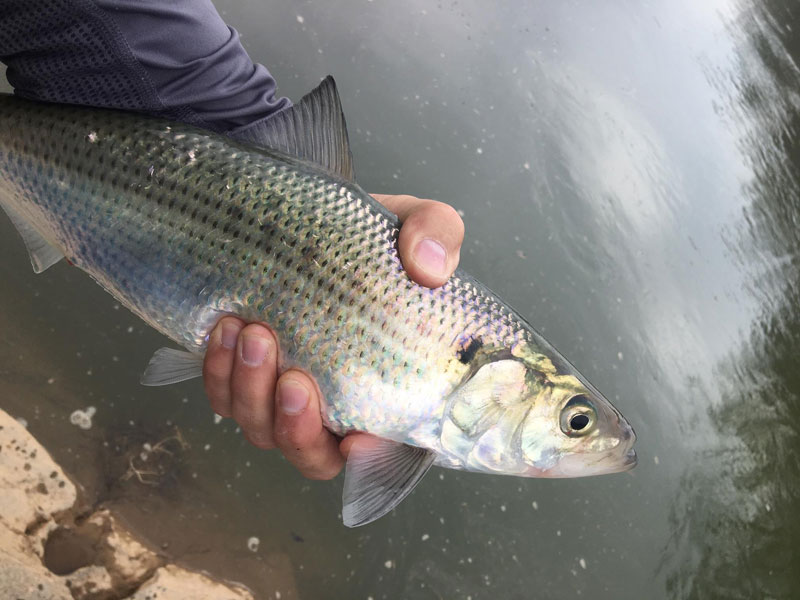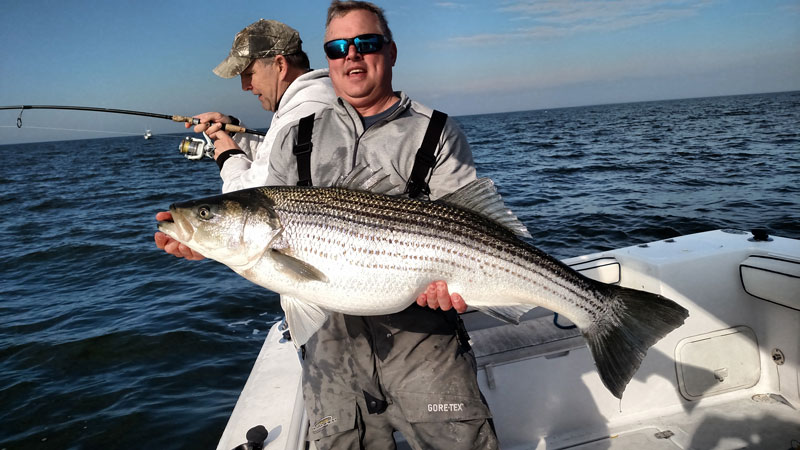Whether you live in Maryland or Virginia, you've probably noticed that fishing in the Potomac River comes up in our fishing reports all the time. It feels like a "home" river to many of us, and since it winds through Washington, DC you might even call it the nation’s river. No matter where you may live one thing is for sure: it’s an excellent fishing destination for a wide range of species, habitats, and hotspots. Be sure to visit these 10 stand-outs.

Dam 5 to Dam 3
The Harpers Ferry vicinity up to Dam 5 west of Hagerstown supports the largest walleye population on the Potomac, and one of the best walleye fishing opportunities in the region. Supplemental stocking began in the river in 2012, and as a result surveys have shown a steady improvement in the walleye population. These fish are now keeper-sized, and the 2018 electro-fishing catch rate of 17.3 adult fish per hour was well above the 10-year average of 14.1.
Hot Bait: Four-inch twister tails in chartreuse or white in clear water, root-beer and earth-tones when the water’s discolored; three- to four-inch crankbaits.
Hot Season: This is a year-round fishery, with the best fishing often in the cooler months of the year.
Hot Tip: Fish early, fish late, and fish on cloudy days. Walleye tend to bite best in low-light conditions.
Fletchers Cove
This is the area where the Potomac seems to magically morph from a freshwater river into a tidal tributary. It’s also a prime spot to visit for the shad run. Though this is an all-release fishery the amazing jumps of the “poor man’s tarpon” attract hordes of anglers to this spot every year.
Hot Bait: Shad darts, tiny spoons, and tubes of various colors. Many anglers tie them into tandem rigs.
Hot Season: These fish usually arrive in late March or early April (weather-dependent), peak in mid- to late-April, and may be caught through May.
Hot Tip: This place is an utter madhouse on a nice weekend day. Do your best to be here on a Wednesday, and you won’t regret it.

Washington, DC
This segment of the Potomac has some of the best fishing on the face of the planet for bottom feeders. No, we’re not talking about when politicians go fishing after work – we’re talking about the mega-mighty blue catfish. Right in the nation’s capital (and often all the way down to Indian Head) all you need to find is a deep hole or channel edge, preferably with some structure (yes, that does include bridge pilings), sink cut baits to the bottom, and hold on tight. Read Monster Catfish, for the details on how to target these fish.
Hot Bait: Cut gizzard shad, or just about any other fish. Menhaden, herring, chicken liver, and chicken breast work well but since they’re softer, get stolen more frequently.
Hot Season: All year long.
Hot Tip: Remember that blue cats are sensitive to barometric pressure and may shut down after a strong front moves through.

Mattawoman Creek
Long known for bass fishing and perch runs, these days Mattawoman get a lot more attention from anglers – or hunters – chasing after one of the region’s newest invaders: the snakehead. While it’s true that fishing and bowhunting pressure has cut their numbers in recent years, this is one of the original areas where snakeheads got a foot-hold and as a result, the true trophies are found here. The proof? In 2018 a new Maryland record was set when bow fisherman Andy Fox shot his arrow through a 19.9-pound, 35-inch snakezilla. Check out Destination: Snakehead, to get the skinny on targeting snakes.
Hot Bait: Plastic frogs and topwater in the warm months; large minnow in cooler months.
Hot Season: Though you can catch snakes here from early spring through late fall, late spring and early summer is usually best.
Hot Tip: In late spring and early summer look for their “fry balls” (schools of fry). Snakeheads are protective parents, and will attack lures they perceive as threatening their young.
Aquia Creek
This is another creek off the main river that’s best known for bass and perch… at least, it used to be. Snakeheads run rampant here too, particularly in and around weedbeds and lillypads.
Hot Bait, Season, and Tip: See above.
Route 301 Bridge
Fishing around the bridge offers numerous opportunities. All year long you can encounter catfish here, most of the summer white perch can be plucked from around the pilings, and in the fall there’s often a good shot at stripers. What really makes it stand out, however, is that once summer sets in this is about as far up-river you can go and have a realistic shot at catching croaker. True, croaker fishing has been below par for several years now. But historically speaking this is a great place to try for ‘em, and once we see a good run in the open Bay again, you can bet that it will be a solid destination for croaker fishing.
Hot Bait: Bloodworms on a bottom rig.
Hot Season: Summer, and into the middle of fall.
Tip: Try night-fishing for croaker. They become very active in the dark, usually an hour or two after the sun goes down.
The Coles Point/Tall Timbers/Piney Point Triangle
This has always been a good zone to fish, but particularly in the past couple of seasons, has held one of the steadiest schoolie striper bites in the region. Summer trolling works well in this area with six-inch lures, those into chumming anchor up along the drop-offs in the 18- to 25-foot range, and anglers who enjoy jigging for stripers look for birds or marks to drop on along the edges.
Hot Bait: Chumming with bunker is usually the number-one way to catch ‘em up.
Hot Season: Early summer through late fall.
Tip: Try mixing razor clam, soft crab, or a live spot in with your bunker baits, when the fishing is tough.

Point Lookout State Park
This may not be a part of the river itself, but we need to recognize its importance since it gives anglers who don’t have access to a boat a shot at the various saltwater species the Potomac can provide. Bottom fish like spot and croaker, bigger game like bluefish and striped bass, and unexpected treats like flounder and puppy drum are all possible catches here, from both the causeway and the 710-foot fishing pier (night fishing is allowed, with a permit).
Hot Bait: It varies quite a bit, but generally speaking bloodworms for the bottom fish and bunker or spot for larger game.
Hot Season: Early summer through late fall.
Hot Tip: Bring a large rod and a small one; use the small one to catch spot, then cast out live four to six inchers on the big rod or cut larger spot to offer the stripers and blues some fresh bait.
The Mouth of the Potomac
There are so many fishing opportunities here it’s very, very tough to focus on just one. But when the chips are down you’ve got to land on stripers. You may find them just about anywhere between Maryland and Virginia but the drop-offs just south-west of Point Lookout and just north of Vir-Mar Beach are prime territory, and often fish here are highlighted by flocks of diving birds.
Hot Bait: It varies, but jigging, trolling, and chumming are all highly effective at different times.
Hot season: Early summer through winter, but the stand-out time here is late fall and early winter when hordes of fish often prowl the 35- to 40- foot zone. Some very fat fall stripers are often caught between Point Lookout and the Coan River.
Hot Tip: Bounce chartreuse and white soft plastics right on bottom, for those late season fish.
Smith Point
Sure, the striper fishing’s great around here, too. Yes, there’s a huge range of other species area angles can target. But we’re calling out Smith Point as one of the northernmost areas you can consistently target cobia. These potent predators are among the biggest, strongest fish you’re likely to encounter in the Chesapeake and that alone makes a trip to Smith Point worthwhile.
Hot Bait: Live eels and bunker chunks, fished in a chum line.
Hot Season: Mid-June through September.
Hot Tip: Anchor in 20- to 25-feet of water on the up-current side of a ledge.
Sign up here to get the weekly FishTalk Chesapeake Bay and Mid-Atlantic fishing reports in your email inbox, every Friday by noon.